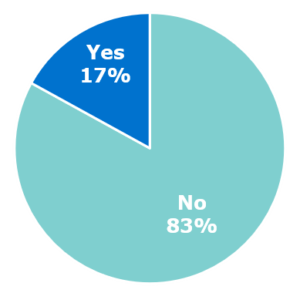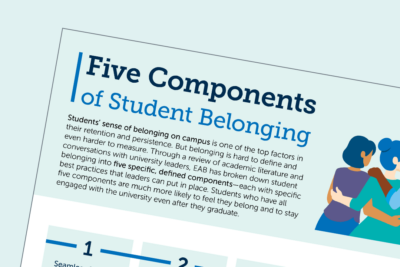How 50 student affairs leaders are feeling about student activism this fall
Only weeks into the fall semester, we are starting to get a clearer view of the student activism terrain this year. Across the past few weeks, we surveyed about 50 student affairs leaders to understand their predictions and top-of-mind concerns regarding student activism this fall.
Download a Detailed Report on Survey Findings
Here are the top three key takeaways from the survey.
1. Most institutions do not have an established process for responding to student demands or a protocol for student demonstrations
The majority of institutions surveyed do not have a protocol for responding to an active student protest or a formal process for responding to student demands.
A protocol in the event of a student demonstration

A protocol to respond to student demands

Across the board, student affairs leaders are anticipating an increase in student activism online, on-campus and in the community.
To maximize positive outcomes for both students and the institution, it is essential for leaders to take steps now to plan a procedure for responding to student activism on campus (especially for institutions who have welcomed students back to campus amidst COVID-19).
Why you should act now:
Student activism will increase this semester across all formats. Protests have been on the rise nationwide and the 2020 presidential election is quickly approaching. Now is the time to prepare to support student activists by solidifying a plan. Additionally—as EAB expert Alex Bloom outlines in “Why colleges should have fewer students on campus this fall“—now is the time to change course and de-densify campus as much as possible, especially when higher education leaders are not confident they will be able to keep students socially distant.
2. Student affairs leaders feel least prepared to follow and respond to student activism online
COVID-19 sparked a migration of student activism from the campus square to social media. Although many students are still physically gathering to protest in their communities, many have adapted their planning process and advocacy campaigns to an online format to increase accessibility amongst their peers. Social media has been a growing trend among activists for years, but much like many digital transformations sparked by COVID-19, the trend of online activism has grown expeditiously over the past 6 months. Students are innovating to find new ways to influence change in a virtual environment. Check out this recent example of how resident advisors at Cornell University offered a student-demand focused training for their RA colleagues at other institutions.
It is no surprise student affairs leaders are feeling the pressure to adapt their methods of tracking and responding to student activism. When asked to rate their preparedness of tracking student activism online, 61% of respondents said they felt unprepared. When asked to rate their preparedness of responding to student activism online, 95% of respondents indicated they felt there was room for improvement (56% said they felt unprepared).
Why you should act now:
As student activism transforms and adapts to a virtual-first environment, students are adding another tool to their activism toolbox, which will likely be here to stay, even in a post COVID-19 environment.
3. Most respondents do not feel confident when it comes to building trust with student activists
Student affairs leaders ranked the following topics as areas of confidence this fall: releasing statements about current events, aligning a response with the institution’s values, and keeping students safe from harm during a protest. However, several topics which best position student affairs teams to support student activists were ranked low on the preparedness scale including: providing guidance and support to student activists during an event, including diverse student perspectives in university decisions, and among the lowest, only 19% of respondents reported feeling confident in their ability to build trust and strengthen relationships with student activists. This tells us that in order to minimize risk to the institution, leaders are attributing most of their effort to responding to an activist event after it happens rather than putting in the work to position themselves as a resource for students before campus flashpoints occur.
This raises the question, why aren’t university leaders attributing more effort and resources to supporting student activists rather than mitigating risk during or after activist events? Student affairs leaders are often balancing a variety of urgent priorities. Among many pressing priorities, it is challenging to be proactive about support for activists rather than responding when activism rises to a level at which it demands attention. However, another interesting trend arose in the survey data that could provide some insight; “Aligning a response to an activist event with the values of the institution while simultaneously supporting student activists,” was ranked as one of the top 3 concerns among student affairs leaders regarding student activism this fall.
However, 71% of respondents feel prepared when it comes to aligning a response to an activist event with the values of the institution. In other words, when supporting student activists is added as a component to aligning a response with institutional values, the response becomes a source of concern rather than a source of confidence for student affairs leaders.
-
Aligning a response with institutional values...
71% feel prepared
-
...while also supporting student activists
68% ranked as a top 3 concern
It could be that many student affairs leaders are operating within an organizational culture in which they do not feel empowered to support student activists. Unsure of current boundaries and limitations, some may be hesitant to take any next steps because they may not be sure which ones are in the right direction. This presents an opportunity to proactively evaluate and identify which methods of student activist support fall within institutional values and guidelines, and which do not. If student affairs staff have a clearer understanding of existing boundaries and limitations, they will feel confident determining next best steps in the moment.
Why you should act now:
Higher education leaders must be regularly and actively engaged in building trust and supporting student activists to normalize incorporating student voices in a cooperative way. This poses less risk to the institution than student protests or student demands and provides a greater benefit by incorporating student insights into university decisions and initiatives.
More Resources

Student Experience and Well-being Resource Center

Addressing Free Speech and Student Activism on Campus
